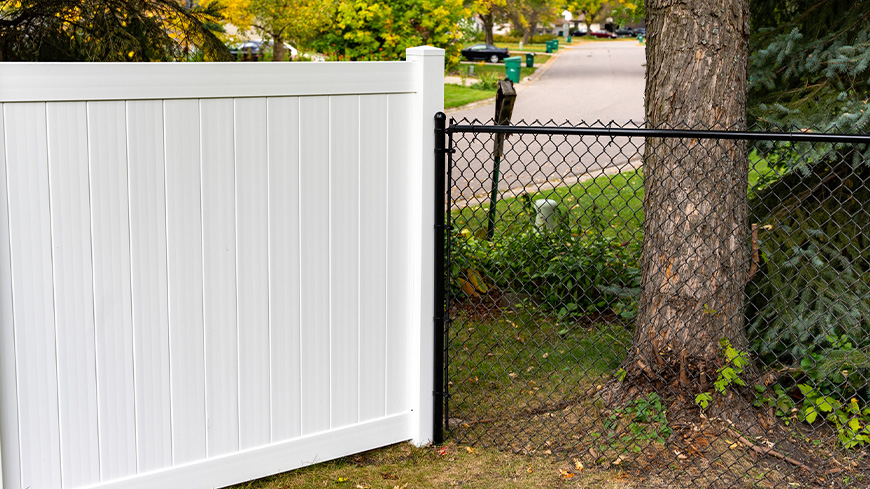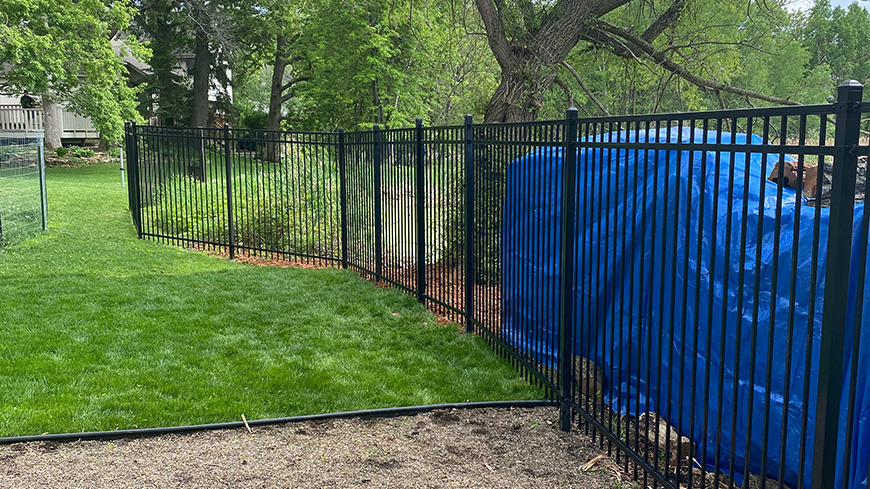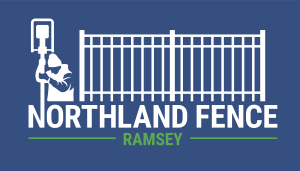
Congratulations, you just bought your first home! Or maybe you’re in the process of revisiting some old desires for your yard that fell to the wayside thanks to your busy life. Either way, you have your dream home, but there’s one problem: your yard is weird. It’s beautiful, though! You fell in love with the treeline that forced your yard into a circle shape to avoid its trunks, and your personal hill in the back that is the pride of Minnesota during sledding season. It’s just that a typical square fence isn’t going to cut it.
Your unconventional yard actually doesn’t have to be a problem at all. The average yard in Minnesota is a couple of thousand square feet bigger than a hockey rink, and while most yards aren’t actually shaped like hockey rinks, maybe yours is! If that’s the case, it’s all good, because there are plenty of fence options for you, too. Even hockey rinks need barriers to keep players from getting out, after all.
Hopefully, your kids and pets aren’t as violent as hockey players, but at Northland Fence Ramsey, we offer a lifetime warranty on vinyl fencing and a 15-year material warranty on all others. We have confidence that any fence we install for you will hold up, just like those trustworthy walls of your local hockey rink that people get smashed against over and over again.
Metal fencing tends to be the best for oddly shaped yards, but vinyl and other materials aren’t out of the running. Let’s talk about why.

Context is key when it comes to choosing fencing for any yard, but especially when it comes to finding the best fence for oddly-shaped yards. More than just choosing the right fence material for your location and home’s aesthetic, you need to consider what will work best logistically for any curves and slopes on your property.
Before really looking into fences for your yard, you’ll want to take measurements of everything, including the slope of your yard. Fencing contractors (like Northland Fence Ramsey) are specially qualified to help you do this due to their experience, but you can also measure the slope yourself if you really want to.
If you fall in the latter camp, that means you’ll have to do some math, which is part of why we recommend avoiding it. No layman should be forced to do more math than they need to. If you insist, however, allow yourself to be transported back to math class. Do you remember the formula for slope? Rise over run? Ring any bells? If not, the “rise” measurement is the vertical part; think of it like a highrise building. The “run” is the horizontal part, which you can think of as the direction you would quite literally run in. You’ll want to divide the “rise” number by the “run” number to get your slope.
If you’re lucky and have the elevation information and property measures of your yard, you can do this math easily. If you aren’t, that means you have to put in some work to get your numbers. We recommend getting two stakes, some string, and a carpenter’s level. Pound a stake into the ground at the level top of the slope and the level bottom of the slope. Tie the string to the top stake at ground level, then run it down to the stake at the bottom of the slope. There, you’ll want to hold the string against the bottom stake. Hold the carpenter’s level on top of it, and raise the string up and down until the bubble of the level is perfectly in the middle. Then, tie a knot in the string there. Measure the distance from the knot in the string to the bottom of the bottom stake. That’s your slope’s “rise,” and then the distance of the whole string from the top stake to the bottom stake is the slope’s “run.” After that, you’ll still have to do math to get your slope. Is all of that work worth it? It’s up to you.
After you have your measurements, you’ll be better equipped to choose the right fence for you. There are three major options that work for even the weirdest of yards.
Racked/rackable (sometimes referred to as raking) fencing is a great option for sloped yards. Unlike traditional fencing, which is in a rectangular shape, racked fencing panels run like a parallelogram along the slope to give it a uniform, gapless look, no matter what the level of the yard is like. Racked fencing is metal, because metal fencing panels are constructed in a way that allows for a pivot feature where the pickets (vertical bars) of the fence attach to the rails (horizontal bars) of the fence. This pivot feature makes it so the racked fencing can be adjusted to fit any yard’s slope without too much trouble.
Racked fencing has its limits, though. It can generally only work for a 12-inch rise every six horizontal feet, so it doesn’t work for super steep slopes. Stepped fencing tends to work better for that.
Stepped fencing is an option if you have a sloped yard, too, especially if parts are very steep or you have lots of hills. Stepped fences are pretty straightforward; as the name suggests, they look like steps. One fence panel will start at the top of the slope, and as you go down the slope, each fence panel will be placed a little lower, creating a “step” effect at the top of the fence.
Whether a stepped fence is the way to go for your steep yard or not is pretty much a matter of personal preference. The fence won’t look uniform, so if you want consistency in your fencing, a racked fence might be a better option for you. You will ultimately have more design options with stepped fencing, though. With racked fencing, you’re confined to metal, but you have a lot more options for materials when it comes to stepped fencing, as well as designs and colors.
You can also still make a yard lovely and safe for pets and children with stepped fencing, even with their slightly “lopsided” nature. Just take it as a challenge to include rocks, plants, and other landscaping features to fill out the uneven parts of the fence.

Unlike the straightforward name of stepped fencing, curved fencing’s name is deceiving. The fence panels themselves don’t actually curve – if they did, you would have a structurally unstable, useless fence. The straight panels just run together in a smooth curving shape for property lines that aren’t straight.
Installing a new fence is exciting, but there are some other things you need to consider before jumping into the process. If you live in a neighborhood, check with your HOA for any regulations on fencing. They may want the entire neighborhood’s fencing to look uniform, and this could have a huge impact on your plans.
You’ll also need to think about building codes, which are complicated, and how you want to install your fence. If you’re a do-it-yourselfer, it may be tempting to take on this project yourself, but we’d recommend calling fencing contractors, especially if you have a strange property that will need some extra care.
If you’re looking for a family-owned, highly-rated fencing company, Northland Fence Ramsey has you covered. We’re the highest-rated fencing company in Minnesota, and we’re available year-round to install fencing for you, unconventional or otherwise. Call us for a free quote at 763-316-4881.
Whether you’re looking for a beautiful, maintenance-free vinyl privacy fence, a sturdy chain link fence, or a ornamental fence, we’re ready to show you why we’re Minnesota’s highest and best rated fence company.
Use this form to request a free estimate or call us at 763-325-8211.
6390 McKinley St NW Suite 150
Ramsey, MN 55303
763-710-3899
Monday: 8 AM–10 PM
Tuesday: 8 AM–10 PM
Wednesday: 8 AM–10 PM
Thursday: 8 AM–10 PM
Friday: 8 AM–10 PM
Saturday:8 AM–6 PM
Sunday:9 AM–5 PM
